Musica, 18 Delphini (18 Del), is a yellow giant star located 245 light years away in the constellation of Delphinus (the Dolphin). With an apparent magnitude of 5.506, the star is faintly visible to the unaided eye in good conditions. It is the 12th brightest star in Delphinus. The evolved star hosts an extrasolar planet, a gas giant formally named Arion (18 Delphini b), discovered in 2008.
Star type
Musica is a giant star with the spectral type G6III. It is an evolved red clump giant that has undergone a helium flash and is now generating energy by fusing helium in its core. The star has a mass 2.35 times that of the Sun and a radius 7.19 times the Sun’s. With a surface temperature of 5,071 K, it is around 33.9 times more luminous than the Sun.
18 Delphini spins with a projected rotational velocity of 1.60 km/s. It has an estimated age of 690 million years, similar to that of the brighter G-type red clump giants Capella (Alpha Aurigae) in the constellation Auriga and Ain (Epsilon Tauri) in Taurus.
Musica is believed to have a mildly active chromosphere and is a source of X-ray emission.
The star has a co-moving companion, reported in 2014. 18 Delphini B appears 29.2 arcseconds south of the primary component. It is a red dwarf star of the spectral type M4-5, with a mass of 0.19 solar masses. The projected separation between 18 Delphini A and 18 Delphini B is 2,199 astronomical units (AU).
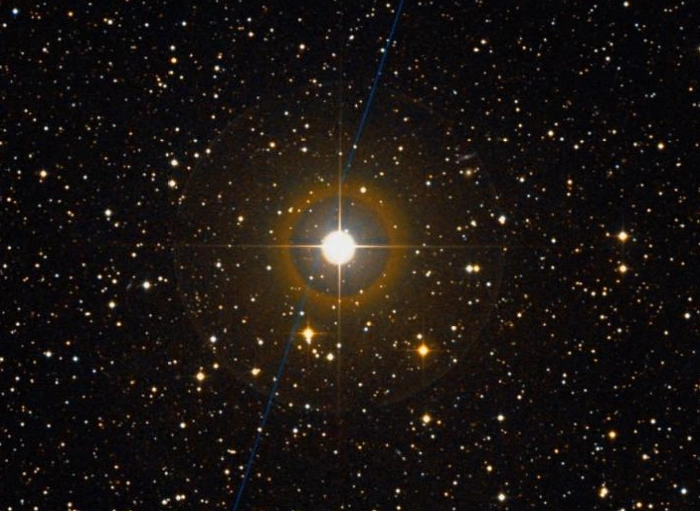
Musica (18 Delphini), image credit: ESO/Digitized Sky Survey 2 (CC BY 4.0)
Planet
Musica has an orbiting exoplanet, 18 Delphini b. Formally known as Arion, the massive planet is orbiting the star with a period of 993.3 ± 3.2 days (2.719 years) at a distance of 2.6 astronomical units (Earth – Sun distances). The planet does not orbit in the habitable zone of 18 Delphini. It is too close to the luminous star for liquid water to exist on its surface.
The presence of 18 Del b was reported by a team of astronomers led by Bun’ei Sato, Okayama Astrophysical Observatory, National Astronomical Observatory, Japan, on February 19, 2008. The gas giant has an estimated mass of 9.207 Jupiter masses and a radius of 1.12 Jupiter radii.
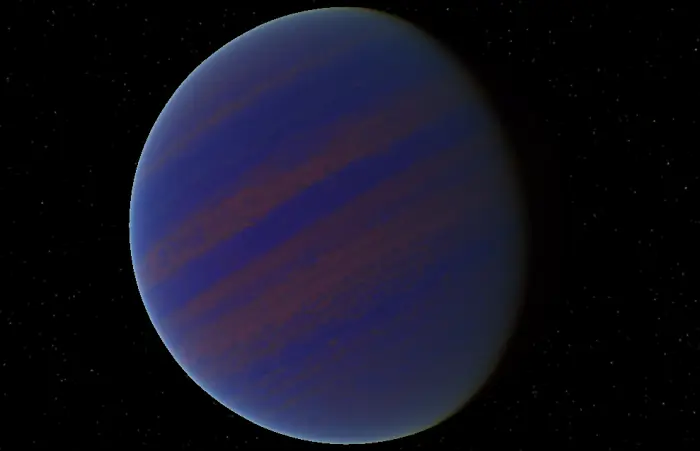
Illustration of Arion (18 Delphini b), image credit: Wikimedia Commons/Tyrogthekreeper (CC BY-SA 3.0)
Facts
Musica is moving away from the Sun with a radial velocity of +4.17.
The star has two optical companions, both invisible to the unaided eye. One has an apparent magnitude of 9.88 and is separated by 197.5 arcseconds from 18 Delphini. The other shines at magnitude 12.77 and appears 129.3 arcseconds away.
The visual companions do not share a common proper motion with Musica and are not physical companions.
Name
The name Musica (pronunciation: /ˈmjuːzɪkə/) is the Latin word for “music.” The name was proposed by the Tokushima Prefectural Jonan High School Science Club of Japan during the International Astronomical Union’s (IAU) NameExoWorlds campaign. It was formally approved by the IAU’s Working Group on Star Names (WGSN) on December 15, 2015.
The planet 18 Delphini b was named Arion during the same campaign, after the Greek poet and musician Arion. In Greek lore, Arion’s life was saved by dolphins, who were enchanted by his playing of the kithara.
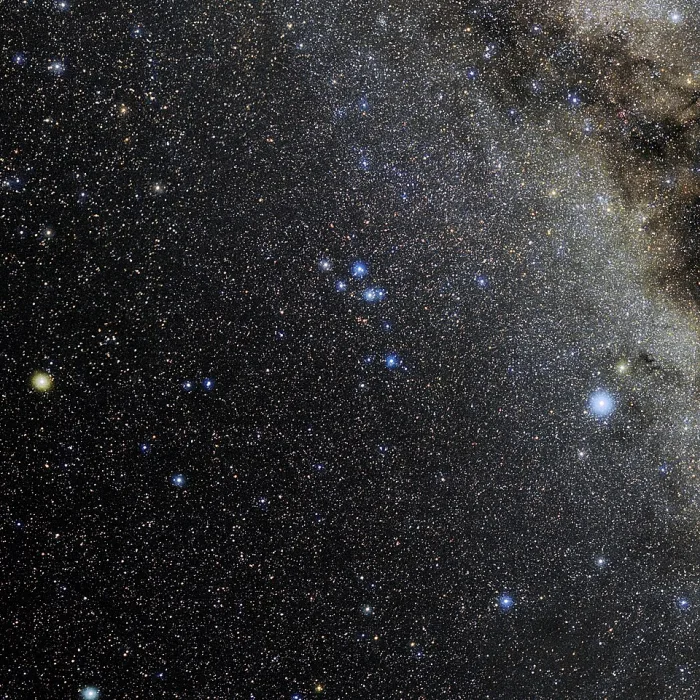
Photo of the constellation Delphinus produced by NOIRLab in collaboration with Eckhard Slawik, a German astrophotographer. Image credit: E. Slawik/NOIRLab/NSF/AURA/M. Zamani (CC BY 4.0)
Location
Musica can be challenging to find because it is a faint star and does not appear in the region of the constellation figure of Delphinus. The star appears more than halfway between Altair in the constellation Aquila and Enif in Pegasus. It lies about a third of the way from Aldulfin at the Dolphin’s tail to Enif. It can be found near the midpoint of the imaginary line connecting Gamma Delphini in the body of Delphinus and Kitalpha, the brightest star in the faint Equuleus.
At declination +11°, 18 Delphini can be spotted from both hemispheres. It is close enough to the celestial equator to be visible from virtually anywhere for at least part of the year.
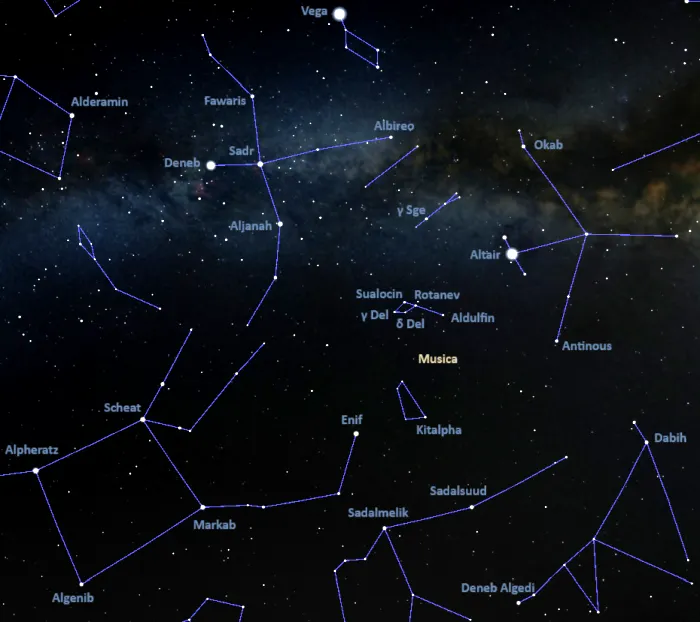
Location of 18 Delphini, image: Stellarium
Constellation
Musica is located in the constellation Delphinus. Located just north of the celestial equator, the celestial Dolphin is one of the Greek constellations, listed by Ptolemy of Alexandria in his Almagest in the 2nd century AD. In Greek mythology, the constellation is associated with Poseidon’s messenger Delphinus, who found the Nereid Amphitrite and persuaded her to marry the sea god. Delphinus is also associated with the dolphin that saved the Greek poet and court musician Arion of Lesbos and carried him to the coast of Greece.
Delphinus is one of the smallest northern constellations, along with the nearby Equuleus (the Little Horse) and Sagitta (the Arrow). It occupies an area of only 189 square degrees and is the 69th largest of the 88 modern constellations.
Delphinus does not contain any stars that make the list of the 300 brightest stars in the sky. The constellation’s lucida, Rotanev (Beta Delphini), is a yellow-white giant star that shines at magnitude 3.617 from a distance of 101 light years.
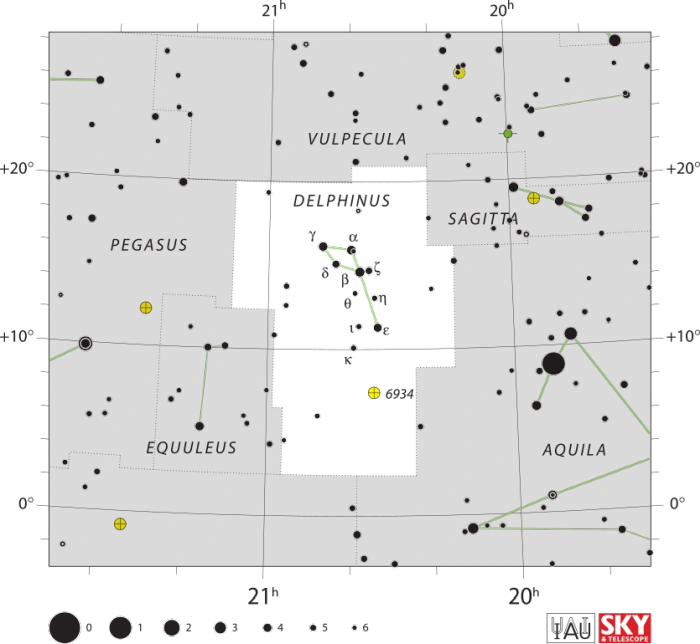
Delphinus constellation map by IAU and Sky&Telescope magazine (Roger Sinnott & Rick Fienberg) (CC BY 3.0)
Other notable stars in Delphinus include the hot blue subgiant Sualocin (Alpha Delphini), the blue giant Aldulfin (Epsilon Delphini), the binary stars Gamma Delphini and Kappa Delphini, the Delta Scuti variable Delta Delphini, the orange giant 17 Delphini, the orange supergiant Theta Delphini, the A-type subgiants Eta Delphini and Iota Delphini, and the A-type main sequence stars Zeta Delphini and Rho Aquilae. Rho Aquilae migrated from the neighbouring constellation Aquila in 1992.
Delphinus also hosts the yellow symbiotic star He 2-467 and the classical nova system Nova Delphini 2013 (V339 Delphini).
Deep sky objects in Delphinus include the globular clusters NGC 6934 (Caldwell 47) and NGC 7006 (Caldwell 42), the planetary nebulae NGC 6891 and NGC 6905 (the Blue Flash Nebula), the spiral galaxies NGC 6956, NGC 7003 and NGC 7025.
The best time of the year to see the stars and deep sky objects in Delphinus is during the month of September, when the constellation appears high above the horizon in the early evening. The entire constellation is visible from locations north of the latitude 69° S.
The 10 brightest stars in Delphinus are Rotanev (Beta Del, mag. 3.617), Sualocin (Alpha Delphini, mag. 3.777), Aldulfin (Epsilon Delphini, mag. 4.03), Gamma Delphini (mag. 4.360), Delta Delphini (mag. 4.43), Zeta Delphini (mag. 4.647), Rho Aquilae (mag. 4.94), Kappa Delphini (mag. 5.05), 17 Delphini (mag. 5.18), and Eta Delphini (mag. 5.38).
Musica – 18 Delphini
| Spectral class | G6III |
| B-V colour index | 0.934 ± 0.004 |
| Apparent magnitude | 5.506 |
| Absolute magnitude | 1.15 |
| Distance | 245 ± 1 light-years (75.2 ± 0.4 parsecs) |
| Parallax | 13.3021 ± 0.0652 mas |
| Radial velocity | +4.17 ± 0.12 km/s |
| Proper motion | RA: −49.921 ± 0.070 mas/yr |
| Dec.: −34.509 0.044 mas/yr | |
| Mass | 2.35 ± 0.07 M☉ |
| Luminosity | 33.9 L☉ (38.2 – 40.8 L☉) |
| Radius | 7.19 ± 0.38 R☉ |
| Temperature | 5,071 ± 10 K |
| Metallicity | 0.10 ± 0.02 dex |
| Age | 690 ± 50 million years |
| Rotational velocity | 1.60 ± 0.45 km/s |
| Surface gravity | 3.00 ± 0.04 cgs |
| Constellation | Delphinus |
| Right ascension | 20h 58m 25.9335294984s |
| Declination | +10° 50′ 21.430869504″ |
| Names and designations | Musica, 18 Delphini, 18 Del, HD 199665, HR 8030, HIP 103527, SAO 106712, BD+10°4425, AG+10 2813, PPM 139372, GC 29266, GCRV 13170, SKY# 39848, CSI+10 4425 1, AKARI-IRC-V1 J2058259+105021, WEB 18832, GEN# +1.00199665, GSC 01107-02709, CSI+10 4425 1MUG 16A, 1RXS J205826.7+105032, TIC 354489950, UBV M 25318, YZ 10 8257, IRAS 20560+1038, 2MASS J20582594+1050214, TYC 1107-2709-1, Gaia DR2 1756741374681702784, Gaia DR3 1756741374681702784, CCDM J20585+1049A, IDS 20536+1027 A, WDS J20584+1050A |